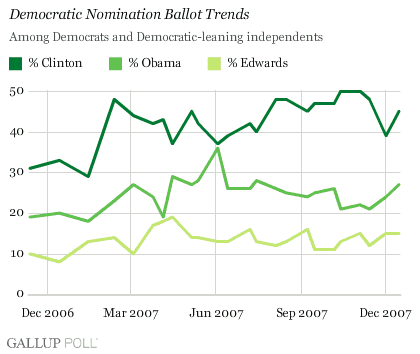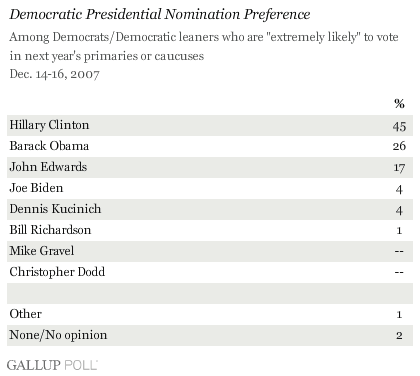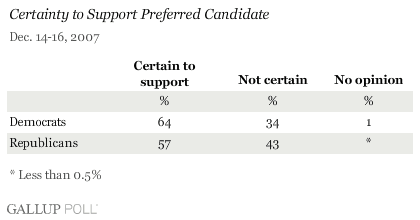PRINCETON, NJ -- Despite extensive news coverage of Illinois Sen. Barack Obama's improved position in Iowa and New Hampshire recently, there has been little change in the positioning of the Democratic presidential candidates on a national level, according to a new USA Today/Gallup poll. New York Sen. Hillary Clinton continues to have a substantial lead over the group of Democrats vying to win the party's nomination for president in 2008. Obama remains a solid second, as he has been all year, with former North Carolina Sen. John Edwards continuing to hold down third place. Clinton's support improved modestly from a dip earlier this month and is nearly back to her high levels from the late summer and early fall. Obama's support has shown a gradual improvement in the past month, and has returned to its late summer/early fall levels.
Democratic Nomination Ballot Trends
The Dec. 14-16, 2007, poll shows that Clinton continues to have a large lead over her competitors, with 45% of Democrats and Democratic-leaning independents saying they support her for the nomination. Twenty-seven percent of Democrats support Obama and 15% support Edwards. Sen. Joe Biden (3%), Gov. Bill Richardson (2%), and Rep. Dennis Kucinich (2%) are well behind in what has pretty much been a three-person race the entire campaign.

The pattern of Democrats' overall support for their party's nomination has not shown much significant change in months, and has in a broad sense been fairly stable through most of the year. In recent weeks, there has been some variation in Democrats' support for the two leading contenders -- Clinton and Obama -- but nothing major enough to affect the race dramatically.
- Clinton's support edged up from 39% in late November/early December to 45% in the latest poll. Her current support level is close to what Gallup measured from August through mid-November, ranging between 45% and 50% during that time.
- Democrats' support for Obama has gradually increased in the past month, rising from 21% in mid-November to 27% in the latest poll. Obama's support was highest in early June, when 37% of Democrats supported Clinton and 36% Obama.

If the race for the Democratic nomination narrows down to just Clinton and Obama, 55% of Democrats say they would prefer Clinton, while 38% would prefer Obama. Clinton has maintained a double-digit lead over Obama on this measure in all but one poll this year. Her largest lead was 31 points in early September (63% to 32%), and her smallest lead was just three points in June (49% to 46%).

Clinton also maintains a substantial lead among the 55% of Democrats who say they are "extremely likely" to vote in next year's caucuses and primaries. Forty-five percent of these Democratic voters support Clinton to win the party nomination, while 26% support Obama and 17% Edwards.

The poll also asked Democrats whether they are certain to support their preferred candidates in next year's caucuses and primaries, or whether they are not certain. Nearly two in three Democrats, 64%, say they are certain to support their candidate, while 34% say they are not certain. By comparison, Republicans interviewed in the same poll are somewhat less likely to be certain about their current candidate preferences: 57% of Republicans and Republican leaners say they are certain to vote for their preferred candidate and 43% are not.

Clinton and Obama supporters are overwhelmingly likely to say they are certain to vote for their preferred candidate. Seventy-three percent of Clinton supporters say they are certain to vote for her, while 24% are not certain. Among Obama supporters, 66% are certain to vote for him, while 34% are not.
Survey Methods
Results are based on telephone interviews with 1,011 national adults, aged 18 and older, conducted Dec. 14-16, 2007. For results based on the total sample of national adults, one can say with 95% confidence that the margin of sampling error is ±3 percentage points.
For results based on the sample of 399 Republicans or Republican leaners, the maximum margin of sampling error is ±5 percentage points.
For results based on the sample of 513 Democrats or Democratic leaners, the maximum margin of sampling error is ±5 percentage points.
In addition to sampling error, question wording and practical difficulties in conducting surveys can introduce error or bias into the findings of public opinion polls.
